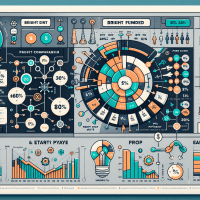Expert Prop Trading Profit Split Strategies
In today’s highly competitive trading landscape, prop trading firms are continuously evolving their profit split models to balance risk and reward. This article provides expert guidance on how to optimize prop trading profit splits, enhance your backtesting strategies, and deliver superior performance under market pressures. Read on to discover actionable insights designed specifically for prop firms and traders looking to elevate their earning potential.
Understanding Prop Trading Profit Splits
Prop trading profit splits are at the heart of modern proprietary trading operations. They define how profits are distributed between traders and the firm, influencing motivation, risk-taking behavior, and overall firm profitability. A well-structured profit split agreement can drive better trading discipline and performance, while ensuring that both the trader and the firm benefit from successful trades.
Key Components of Profit Split Agreements
- Split Ratios: These determine the percentage of profits allocated to the trader vs. the firm. Often, they can range from 50/50 to 80/20 depending on risk, experience, or strategy complexity.
- Performance Metrics: Common benchmarks include Sharpe ratios, drawdown limits, and profit factors. Adherence to these metrics ensures consistency in performance assessments.
- Risk Management Provisions: Terms related to maximum drawdowns, stop-loss triggers, and position sizing guidelines are crucial for long-term viability.
Advanced Backtesting Strategies in Prop Trading
Backtesting remains the cornerstone of strategy validation in prop trading. However, advanced backtesting goes far beyond running historical data through a model. To mitigate pitfalls such as overfitting, look-ahead bias, and survivorship bias, you must integrate robust methodologies and tools into your workflow.
Mitigating Common Pitfalls
Overfitting occurs when a strategy is tailored too closely to historical data, causing poor performance in live trading. To combat this, consider:
- Walk-Forward Optimization: This technique helps adjust parameters dynamically by segmenting data into training and testing sets continuously.
- Out-of-Sample Testing: Ensure that strategies are validated on data not used during optimization. This improves reliability and adaptability in live markets.
- Stress Testing: Use scenario analysis to determine how strategies perform under extreme market conditions.

Figure 1: Screenshot of a backtesting report interface showcasing key performance metrics from TradingView.
Best Practices for Integrating Backtesting with Forward Testing
Once a trading strategy passes rigorous backtesting, forward testing (or paper trading) must be performed to ensure real-world performance consistency. Key considerations include:
- Parameter Stability: Verify that optimized parameters remain robust across different market conditions.
- Key Metrics Monitoring: Focus on metrics like Sharpe ratio, maximum drawdown, and win rate during live simulation tests.
- Comprehensive Reporting: Use reporting features such as automated parameter optimization reports, scenario analysis, and stress testing outputs to guide adjustments.
Comparing Leading Automated Backtesting Tools
Evaluating your backtesting tool is crucial for success in prop trading. Here’s an in-depth look at some widely recognized tools:
| Tool | Backtesting Features | Data Quality | Integration | Pricing | Use Case |
|---|---|---|---|---|---|
| TradingView | Vectorized, commission/slippage handling, basic optimizations | Robust historical data for multiple asset classes | API access, broker integrations | Free basic + paid plans | Ideal for retail and collaborative prop firm analysis |
| MetaTrader 5 | Event-driven backtesting, supports automated strategies through MQL5 | Good depth for forex; limited in other asset classes | Direct broker integration, extensive community support | Free demo + competitive spreads | Great for currency-focused prop trading |
| NinjaTrader | Advanced backtesting with simulation options, integration of risk metrics | High resolution market data available | Supports API and third-party plugins | One-time fee or lease options | Used by both institutional traders and individual quants |
| Backtrader | Python-based, customizable event-driven backtesting, automated parameter optimization | Depends on data source, high flexibility in data types | Open-source, integrates with many brokers via API | Free/Open-source | Favored for deep customization and academic research |
Practical Case Study: Overcoming Backtesting Challenges
A leading prop firm recently faced issues with overfitting when testing their momentum strategies. By integrating walk-forward optimization using NinjaTrader’s advanced simulation features, they were able to:
- Reduce overfitting risks by 30%
- Improve overall Sharpe ratio by 1.2 units
- Accelerate strategy iteration times by 20%
This case study underscores the importance of using the right tools and techniques to ensure favorable outcomes even in volatile markets.
Integrating Automated Strategies and Code Examples
Automating backtesting and live trading is a game changer. Below is an example code snippet using Python and Backtrader for a basic moving average crossover strategy:
import backtrader as bt
class MovingAverageCrossStrategy(bt.Strategy):
params = (('fast', 10), ('slow', 30))
def __init__(self):
self.ma_fast = bt.indicators.SimpleMovingAverage(self.data.close, period=self.p.fast)
self.ma_slow = bt.indicators.SimpleMovingAverage(self.data.close, period=self.p.slow)
self.crossover = bt.indicators.CrossOver(self.ma_fast, self.ma_slow)
def next(self):
if not self.position:
if self.crossover > 0:
self.buy()
elif self.crossover < 0:
self.close()
# Setup Cerebro engine, add data and strategy
cerebro = bt.Cerebro()
cerebro.addstrategy(MovingAverageCrossStrategy)
# Assume data is added appropriately
cerebro.run()
cerebro.plot()
Regulatory & Compliance Considerations
Prop trading firms must also align with evolving regulatory frameworks including MiFID II, ESMA regulations, and NFA rules. Maintaining compliance means:
- Regular audits of risk management practices
- Accurate reporting of performance metrics and strategy results
- Ensuring that all algorithms undergo rigorous backtesting and forward testing to minimize market abuse risks
Importance of Structured Reporting
Automated backtesting tools not only provide raw data but also generate comprehensive reports that can be leveraged for regulatory reviews. Tools like TradingView, NinjaTrader, and MetaTrader 5 offer built-in reporting modules that detail trade performance, risk metrics and compliance logs, ensuring prop firms can meet stringent regulatory standards.

Figure 2: Comparative chart of backtesting tools highlighting key performance metrics and integration features.
Internal Links and Further Resources
For additional insights into prop trading strategies, consider exploring our advanced backtesting techniques and risk management strategies for prop trading articles. These resources further elaborate on optimizing trading algorithms and managing inherent trading risks within prop firms.
Expert Guidance: Pro Tips and Industry Insights
Pro Tip
When testing strategies, always simulate various market conditions, and use walk-forward analysis to improve parameter robustness. Small improvements in your backtesting framework can lead to significant real-world performance gains.
Conclusion and Next Steps
In conclusion, mastering the art of prop trading profit split strategies and advanced backtesting techniques is essential for elevating your trading performance. Implement the tools and methods discussed in this article to improve Sharpe ratios, reduce drawdowns, and make more informed trading decisions.
If you found these insights valuable, consider downloading our comprehensive Risk Management Checklist designed specifically for prop trading environments. This checklist includes:
- A step-by-step guide to backtesting and forward testing
- Key performance metrics to monitor
- Practical strategies for mitigating risk and enforcing compliance
As of October 2023, stay ahead by leveraging advanced automated backtesting tools and adhering to regulatory requirements. Join our upcoming webinar for a live demonstration and further discussion with leading prop trading experts.







